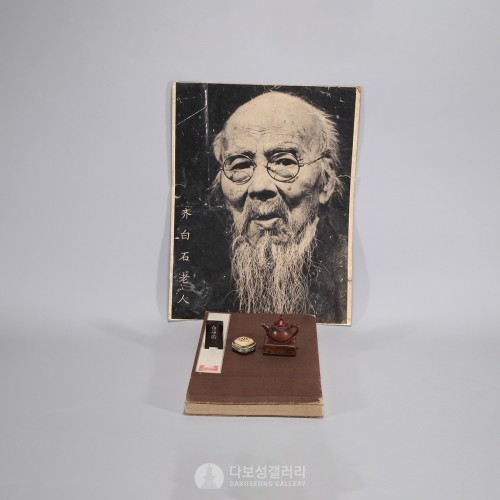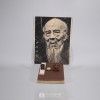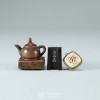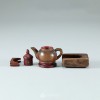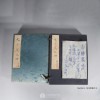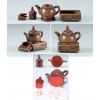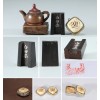본문
중국의 대표적인 근현대 미술가로 ‘중국의 피카소’라 불리는 제백석(齊白石, 1863~1957)의 그림을 모은 화첩과 인장입니다.
제백석의 호는 빈생(瀕生), 백석산인(白石山人), 기원(寄園), 기평(寄萍), 기평당주인(寄萍堂主人), 노평(老萍), 평옹(萍翁), 기환선노(寄幻仙奴), 아지(阿芝), 목거사(木居士), 로목(老木), 삼백석인부옹(三百石印富翁), 행자오로민(杏子塢老民), 차산음관주자(借山吟館主者), 차산옹(借山翁), 성당로옥후인(星塘老屋後人), 상상노농(湘上老農) 등으로 다양합니다.
제백석은 호남성의 가난한 농가에서 태어나 외조부에게 글을 배웠으나 집안이 어려워 학업을 중단하고 15세 때부터 제선우(齊仙佑) 등에게 목공 기술을 배워 목조각으로 유명해지기 시작하였습니다.
특히 꽃을 조각하는 유명한 공예가로도 이름을 알렸습니다.
25세 때인 1888년에 소전흠(蕭傳鑫)과 문소가(文少可)에게 초상화를, 1889년에 호자탁(胡自倬)과 진작훈(陳作壎)에게 초충도와 시문을 각각 배워 그림과 시, 전각에 두루 뛰어난 예술가가 되었습니다.
이 화첩은 자유분방한 필획으로 강한 색채 대비와 대담한 구도를 이용하여 일상에서 볼 수 있는 채소, 꽃, 새우, 게, 병아리, 쥐 등의 친숙한 사물을 그린 수묵담채화 21점으로 구성되어 있습니다.
화폭의 여백에 쓰인 제백석의 글씨는 만년의 추사(秋史)와 마찬가지로 속기(俗氣)가 전혀 없고 고졸미(古拙美)가 넘치는 품격을 보여줍니다.
이러한 제백석의 서화와 함께 그의 뛰어난 목공예술을 보여주는 인장과 시전판(詩箋板), 옥(玉)장신구를 통해 제백석의 높은 예술성을 확인할 수 있습니다.
인장은 손잡이가 달린 주전자 모양이고, 시전판은 ‘ㄷ’자 모양의 목판에 아름다운 무늬를 새긴 판화이며, 옥장신구는 ‘모든 것이 뜻과 같이 된다'는 뜻을 가진 ‘여의(如意)’ 글자를 각각 양각한 두 개의 원판입니다.
이 가운데 시전판으로 찍어낸 아름다운 문양의 시전지는 '화전지'(花箋紙)로도 불리는데, 선비들이 종이에 찍어 편지나 시를 쓸 때 사용한 종이로서 옛날 선비들이 애용하였습니다.
이들 유물을 통하여 ‘중국의 피카소’ 제백석의 높은 공예와 서화 예술을 느낄 수 있습니다.
━━━━━
这是收集了中国代表性的近现代美术家、被称为"中国毕加索"的齐白石(1863~1957年)的画册和印章。
齐白石的号是贫生、白石山人、祈愿、祈平、祈平堂主人、鲁平、平翁、祈桓善怒、阿智、木居士、芦木、三白石人富翁、杏子五老、茶山馆、茶山馆、茶山主人翁、茶山后山人老翁、相祥农舍路。
齐白石出生于湖南省的贫困农户,向外祖父学习文字,但因家境困难而中断学业,从15岁开始向齐善宇等人学习木工技术,以木雕出名。
尤其以雕刻花的著名工艺家而闻名。
25岁的1888年向苏贞钦和文昭嘉学习肖像画,1889年向胡自卓和陈作勋学习草虫图和诗文,成为画、诗、篆刻都出色的艺术家。
该画册是自由奔放的笔画,利用强烈的色彩对比和大胆的构图,由21幅描绘日常生活中常见的蔬菜、花、虾、蟹、小鸡、老鼠等熟悉事物的水墨淡彩画组成。
画幅空白处写的齐白石的字和晚年的秋史一样,完全没有俗气,展现了充满古拙美的品格。
通过齐白石的书画和展现他卓越木工艺术的印章、诗典版、玉饰品,可以确认齐白石艺术高超。
印章是带有手柄的水壶形状,诗展板是在"如"字模样的木板上刻有美丽花纹的版画,玉首饰是将"一切如意"意思的"汝矣"字分别量价的两个原版。
其中,用诗笺板印制的美丽图案的诗笺也被称为"画笺",是儒生们印在纸上写信或写诗时使用的纸张,是古代儒生们喜欢使用的纸张。
通过这些文物可以感受到"中国毕加索"齐白石的高贵工艺和书画艺术。
━━━━━
On behalf of China's modern artist "Picasso of China" Qi Baishi's album, seal.
Qi Baishi's household is near life, Baishishan people, Jiyuan, Jiping, Jiping hall owner, Laoping, pingweng, Jihuan Xiannu, azhi, Mu Jushi, laomu, 300 stone printing rich man, xingziwu old people, the owner of Shanyin hall, the descendant of Xingtang old house, the old farmer of Xiangshang, etc.
Qi Baishi was born in a poor farmer's family in Hunan Province.
His grandfather taught him how to read.
However, due to the poor family environment, he began to learn carpentry skills from Qi Xianyou at the age of 15 and became famous.
Especially good at carving flower craft plus.
In 1888, when he was 25 years old, he studied portrait painting with Xiao Chuanxin and Wen Shao.
In 1889, he studied with Hu ziqu and Chen Zuoyun, and became a versatile artist.
Qi Baishi's free and unrestrained strokes, using strong color contrast and bold composition, mainly described familiar things in daily life, such as vegetables, flowers, shrimp, crabs, chickens, mice and so on. In particular, the title and inscription are masters of font and seal cutting.
The article is the same as the late autumn history, not a bit vulgar, full of the beauty of antiquity.
Through such calligraphy and painting of the white stone, his excellent woodworking art seal, poem board, jade jewelry can be confirmed Qi Baishi's artistry.
The seal is like a kettle with a handle, the poem plate is a woodblock engraving with beautiful patterns, and the word "Ruyi" is engraved on jade jewelry.
Among them, the poem paper with beautiful patterns printed by the Shijian plate is also known as "Huajian paper".
As the paper used by scholars to write letters or poems on paper, ancient scholars liked it very much.
Through these relics, we can feel Qi Baishi's craft, calligraphy and painting art.
